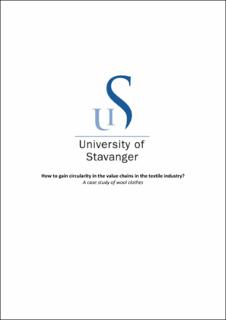| dc.description.abstract | In this master thesis, a case study of wool clothes has been the basis for answering the problem statement on how to gain circularity in the value chains in the textile industry. The textile industry is causing environmental impacts through the production, consumption, and end-of-life phase of clothes. This study has looked at the consumer's behavior regarding the use of wool clothes through a case study. Gathering information about consumers' behavior has been done through a quantitative survey. The respondents were asked questions related to their washing behavior and how they care for their wool clothes.
This study concentrates mainly on the case of wool clothes. Still, cotton clothes have been compared with wool clothes to understand how consumers' behavior might be affected by using and purchasing different textile clothes. The findings show that wool clothes were used longer between washes, washed at lower temperatures, and most respondents were not using a tumble dryer for drying wool clothes. Based on the findings in this study, it may be possible to assume that using wool clothes has lower environmental impacts than cotton clothes and can gain circularity in the textile industry.
This study is also looking at circular business models for wool clothes from a consumer perspective. These circular business models are presented by Lacy & Rutqvist (2015). The study researchers if some of these models could work for the wool clothes industry. The respondents answered that they were willing to repair their wool clothes, related to the circular business model, product life-extension. The respondents also donated wool clothes, which might lead to a circular business model focusing on recovery and recycling wool clothes. Recovery and recycling can, for instance, result in delivering back used clothes to the companies. But on the other hand, a lack of information on sustainability and consumers' behavior regarding environmental impacts can affect how and if businesses can implement circular business models in the textile industry. | |
